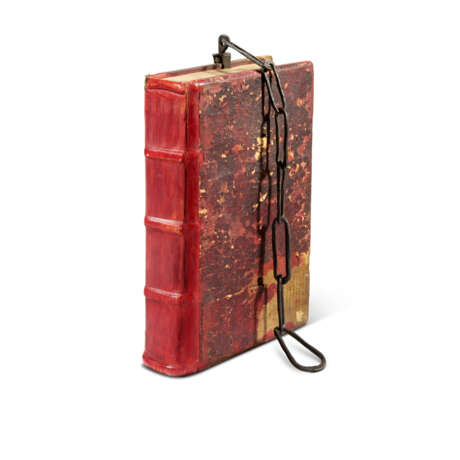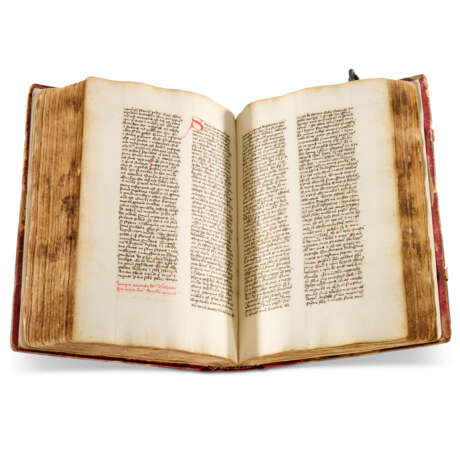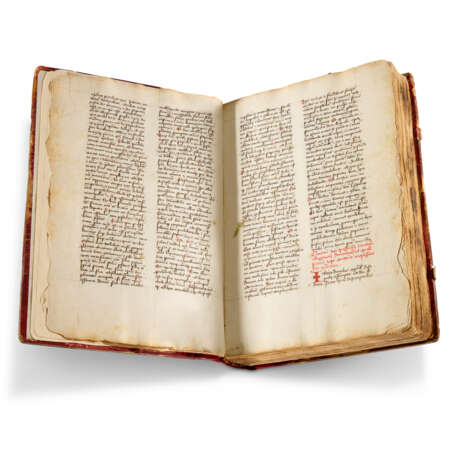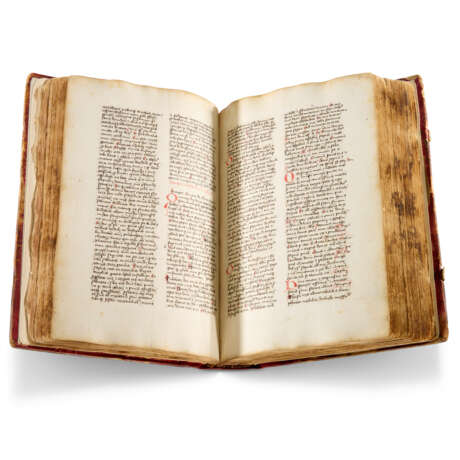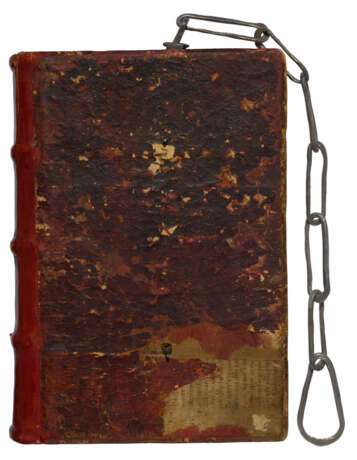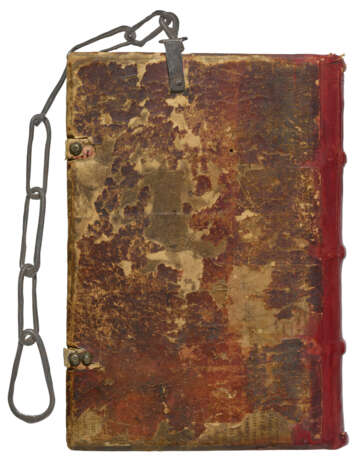ID 1214840
Лот 44 | A theological compendium in a chained binding
Оценочная стоимость
£ 15 000 – 20 000
Compendium including Henricus Suso (1295-1366), Horologium sapientiae and Cursus sapientiae; Jacobus Mediolanensis (fl. late 13th century), Stimulus amoris; Sermons; Quaestiones; in Latin, decorated manuscript on paper [Southern Germany, second half 15th century]
A chained volume of mystical and theological texts.
300 x 205 mm, 266 leave: 19 (of 12, lacking i-iii), 2-1312, 147 ( of 12, lacking viii-xii), 15-1612, 1710, 18-2312, catchwords, reused vellum sewing guards at centre of each gathering, 38-46 lines, ruled space: c.215 x 140 mm, headings, paragraph marks and initials in red, text capitals touched red (lacking three leaves before f.1 and 5 leaves after f.160, corner of f.338 torn with loss of text, margins eroded ff.1-11 and 256-266, slight worming to some margins, text smudges ff.256v-257).
Binding:
15th-century German binding of calfskin over eight strips of reused vellum over wooden boards, two metal pin catches for clasps on upper cover, attachments for two straps on lower cover, chain of seven links, the last the differently shaped terminal link, length approx. 440 mm, attached to top of lower cover by swivel mount, spine in four compartments (leather covers flaking and worn through to boards in places, rebacked, modern endpapers, lacking surrounds of pin catches and two straps, nail in upper strap attachment loose and indenting added endleaves).
Provenance:
(1) From its contents and form, the manuscript was almost certainly written in a monastic house or religious community engaged in theological study as well as spiritual exercises, either for their own library or for that of another community. The Latin is very abbreviated and aimed at an educated readership, as are the Quaestiones, questions, a formal part of the scholastic method taught at universities. The script and the use of paper suggest an origin in Southern Germany.
(2) Sam Fogg, London, acquired in June 1993 by:
(3) The Schøyen Collection, MS 1673.
Content:
Henricus Suso (1295-1366), Horologium Sapientiae, lacking opening of Book I, beginning '[…] spe quam re exultant, quia ventum in horreum suum' (P. Künzle ed., Heinrich Seuses Horologium sapientiae, 1977, p.375 l.28) and ending '[…] vivat et regnat per omnia secula seculorum', ff.1-71v; Cursus sapientiae, the Hours of Eternal Wisdom, ff.71v-73v; prayer attributed to St Bernard, O fons et dulcedo et vita [...] ff.73v-74; Sermons ff.74-164: on the Ascension ff.74, 76 and 79, John the Baptist ff.81v (attributed to St Bernard) and 83, Sts Peter and Paul 85v, Mary Magdalene f.88, James ff.91 and 94, Peter ad vincula, his miraculous escape from prison f.97, Assumption of the Virgin ff.99v, 103, 105 and 107v, St Augustine f.110v, Birth of the Virgin f.113v, Assumption of the Virgin f.116v, Birth of the Virgin ff.119v, 122, 124, 126v, St Bartholomew f.131, All Saints f.135v, St Agnes 137v, Purification of the Virgin ff.140v and 143v, quecumque placet (any occasion) ff.146 and 149v, on the seven deadly sins f.152v, Palm Sunday (lacking end) f.160v, ?for the dedication of a church, opening vere dominus est in loco isto f.161; Ps.-Bernard, De contemptu mundi (Patrologia latina, XL, cols 983-992), ff.164-167v; James of Milan (fl. late 13th century), here attributed to St Bernard, Stimulus amoris, opening 'Surrite' instead of 'Currite' (S. Bonaventura Opera omnia, A. Peltier ed,, 1864-187,vol XII) ff. 167v-179; Henricus de Langenstein de Hassia (1325-1397), Epistola de contemptu mundi ff.179-183v; Sermon for the Dedication and other feasts ff.183v-188, on the Creed ff.188-199v; two sermons on Quasi cedrus, ff.199v-207; sermon ff.207v-214; Jacques de Vitry (c.1165-1240), Homily on the Passion, ff.214-233v; Sermon on Omnia que fecisti nobis Domine ff.233v-241v; on merchants and fraudulent dealing ff.241v-242; Quaestiones with three dealing with the Last Judgement citing Henricus de Oyta (c.1330-1397) ff.242-251; on the Baptism of Christ and the disciples ff.251-252; on penitence and confession ff.252-253v; two writings on mortal sins ff.253v-256; Sermon for the feast of the Holy Innocents ff.256-259; Quaestio on graces ff.259r and v; Sermon to stimulate devotion to Corpus Christi ff.259-266. The eight vellum strips, measuring max. 180 x 70 mm, used on the boards of the binding come from a copy of the Commentaria in Canticum canticorum by Rupert of Deutz (d.1129) dating from c.1200. About forty manuscripts of the work survive; it was edited by H. Haacke, Corpus Christianorum Continuatio Mediaevalis, XXVI, 1974. This comparatively early copy must have been damaged or redundant when it was recycled in the binding.
Within the volume, the texts brought together were clearly all found worthy of study and contemplation: there is an emphasis in the longer works on individual spiritual improvement through meditation aimed at losing the self in Christ. The opening work by the Rhineland mystic, Henricus Suso (Heinrich Seuss), the Horolgium sapientiae, 'Clock of Wisdom', was a Latin version of his vernacular original the Büchlein der ewigen Weisheit, the Little Book of Eternal Wisdom. Although Suso’s work was regarded with some suspicion by his own Order, the Dominicans, it proved enormously popular, in Latin and in German and in the vernacular translations from the Latin. Individuals could relate to Suso’s mystical experiences and spiritual exercises as he pursued wisdom, personified as a lady but also equated with Christ. The modern edition of the Horologium lists 214 complete manuscripts to which the Schøyen copy can be added. The Hours of Eternal Wisdom were also very popular, particularly in the Netherlands where they were a frequent component of vernacular Books of Hours. They not infrequently follow the treatise in manuscript: their inclusion here cannot primarily have been intended for prayer at the liturgical hours of the day, but rather as a supplement to Suso’s treatise.
The Stimulus amoris, 'Pricking of Love', by the Franciscan Jacobus Mediolanensis, James of Milan, whose identity remains uncertain, was frequently attributed to St Bonaventura. In existence by 1293, it too circulated widely but in different versions, since the text continued to be adapted and expanded (see F. Eisermann, “Stimulus amoris”: Inhalt, lateinische Überlieferung, deutsche Übersetzungen, Rezeption, 2001). Focussed on the Passion, it aimed to encourage individual meditation to achieve the spiritual union with Christ that was also Suso’s object.
The Quaestiones of scholastic debate come from the universities. Henricus de Oyta, Heinrich Totting von Oyta from Frisia, who is cited as an authority, was driven from Paris by the Schism and taught in Prague and then in the 1380s in Vienna where he drew up the university’s statutes with Henricus de Langenstein de Hassia, Heinrich Heinbuche von Langenstein in Hesse. It is possible that the compiler had encountered works by these masters during his own studies.
The presence of the sermons does not necessarily indicate an order, like the Dominicans or the Franciscans, where preaching was a central function. Sermons circulated as another form of written work that might be read for personal improvement as well as for teaching. Further investigation of the varied contents would provide greater insight into the spiritual concerns of the community where it was made and where it probably continued to be kept. This volume with its chain conveys the spiritual aims and physical realities of a religious house or collegiate foundation.
| Место происхождения: | Западная Европа, Германия, Европа |
|---|---|
| Категория аукционного дома: | Манускрипты Средневековья и Ренессанса, Книги и рукописи |
| Место происхождения: | Западная Европа, Германия, Европа |
|---|---|
| Категория аукционного дома: | Манускрипты Средневековья и Ренессанса, Книги и рукописи |
| Адрес торгов |
CHRISTIE'S 8 King Street, St. James's SW1Y 6QT London Великобритания | |
|---|---|---|
| Предосмотр |
| |
| Телефон | +44 (0)20 7839 9060 | |
| Комиссия | see on Website | |
| Условия использования | Условия использования |
